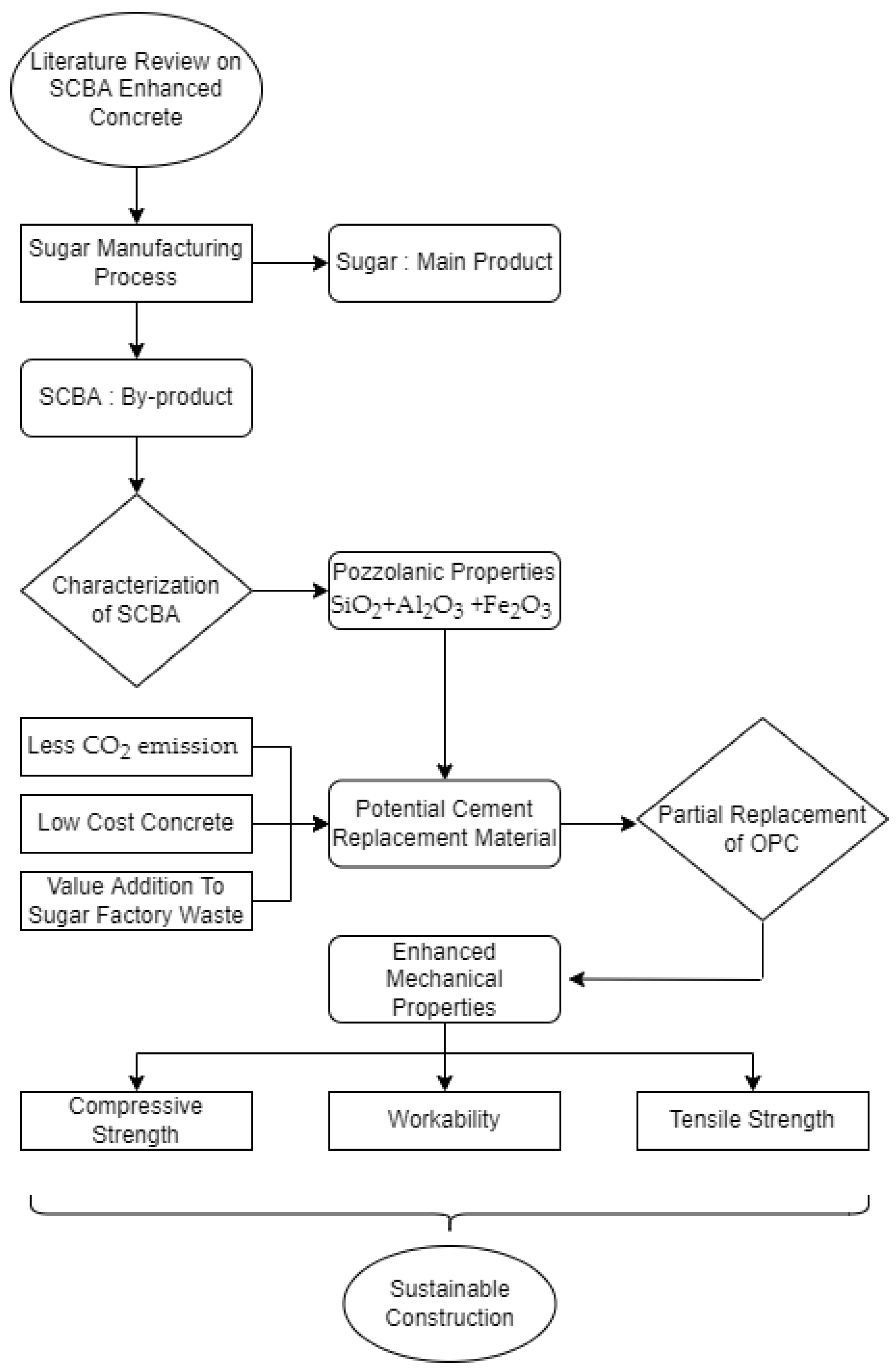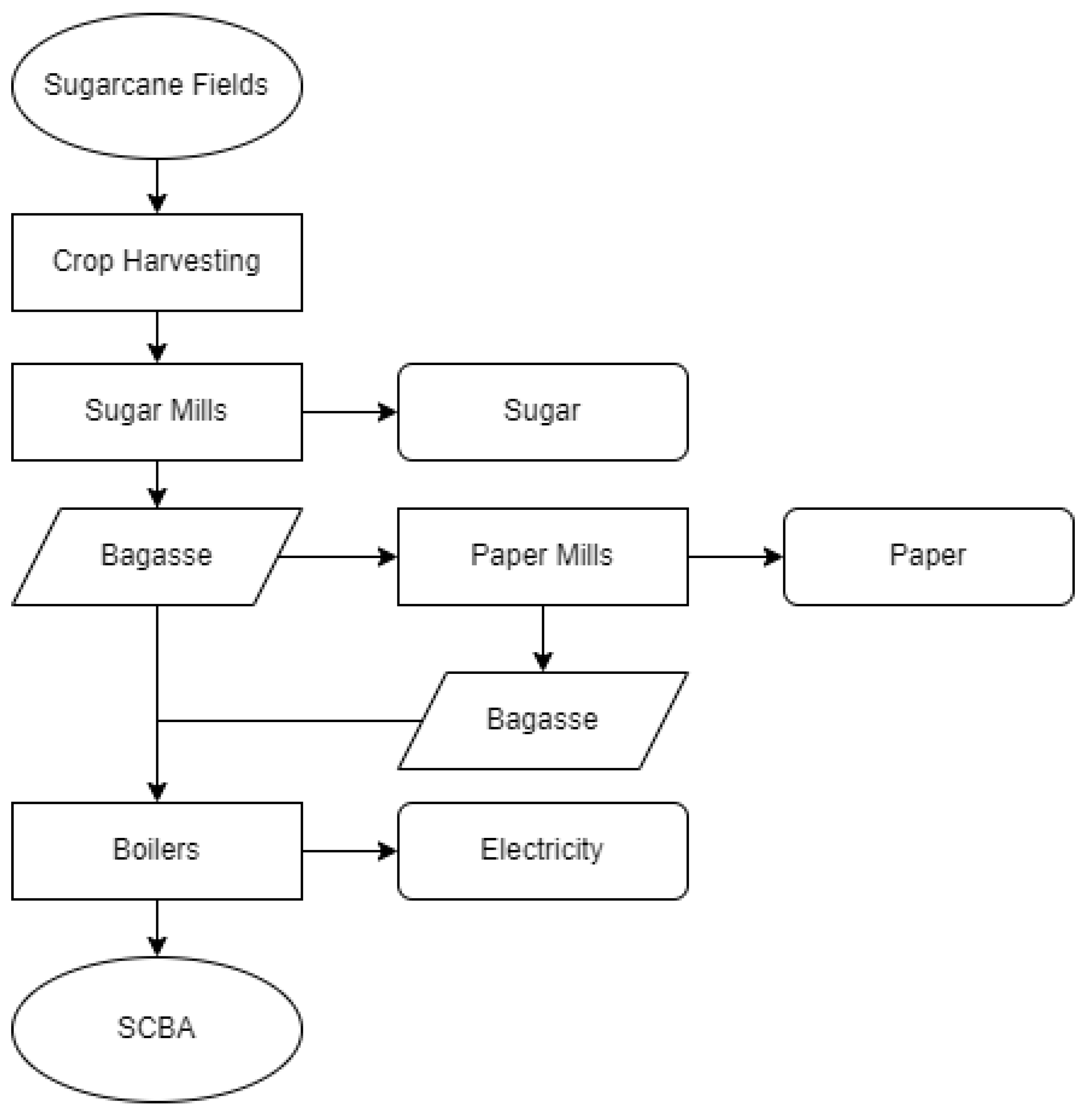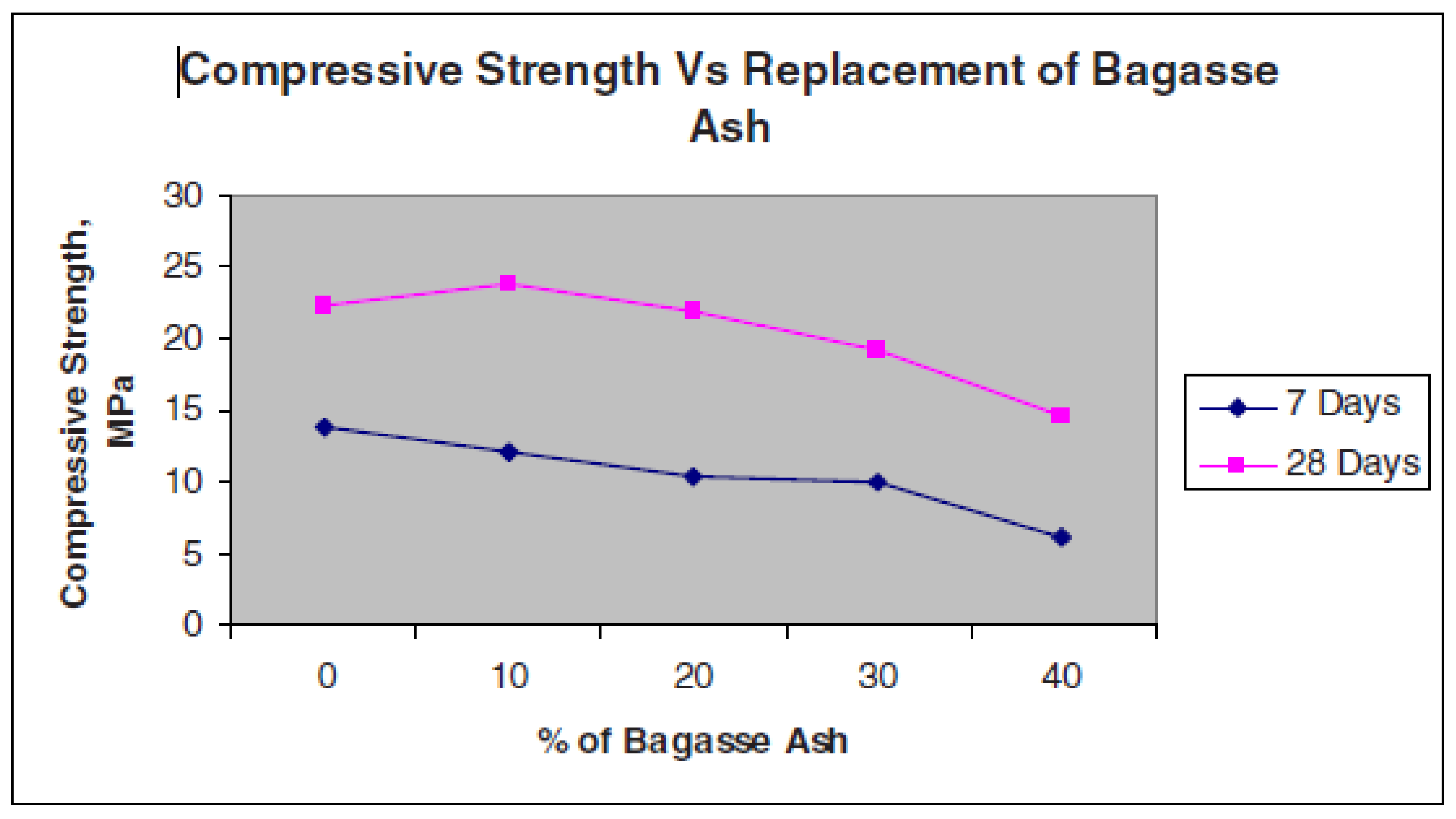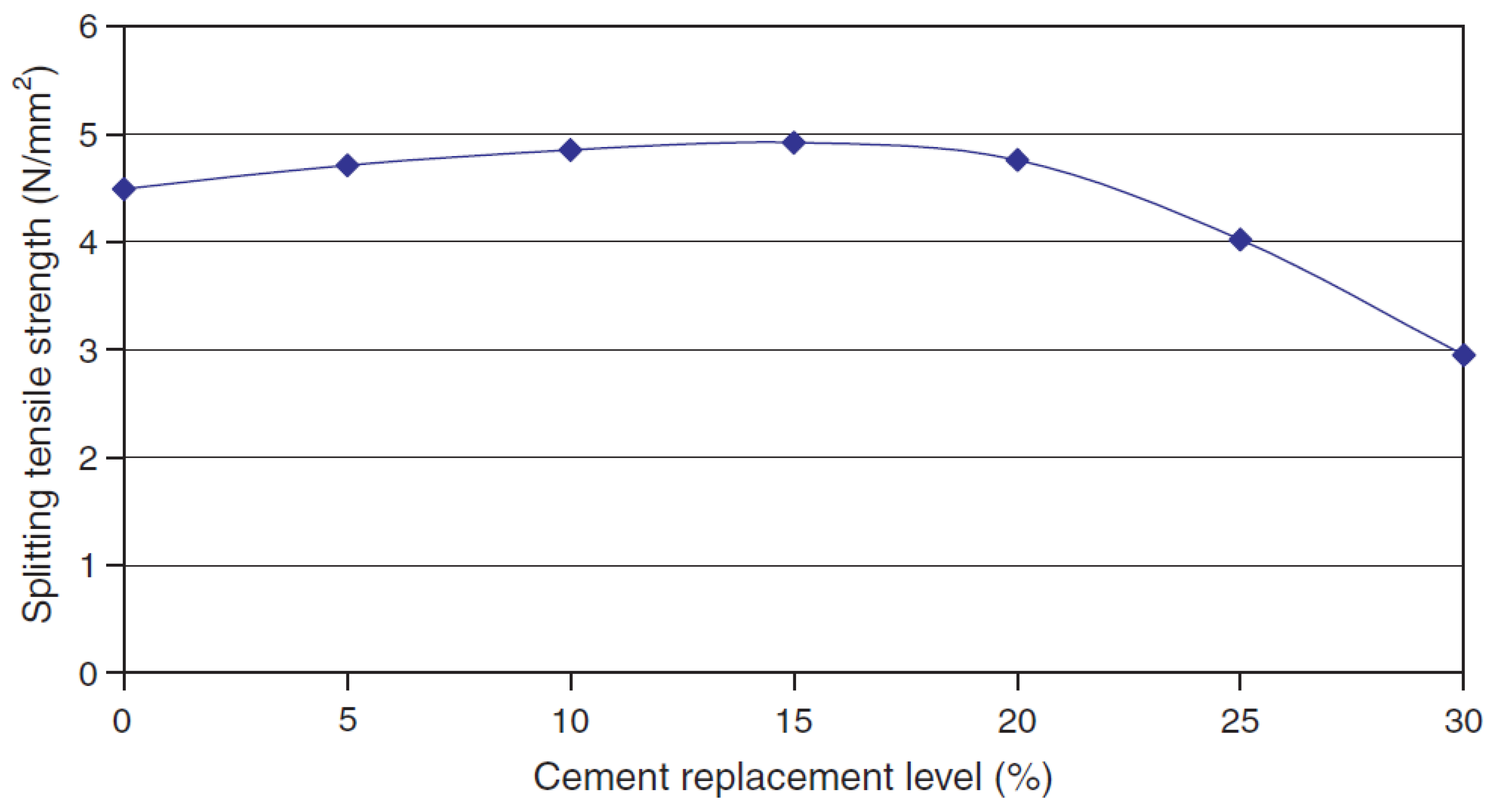A Review on the Optimization of the Mechanical Properties of Sugarcane-Bagasse-Ash-Integrated Concretes
Abstract
:1. Introduction
2. Sugar Manufacturing Industries
3. Sugarcane Bagasse Ash
3.1. Physical Properties
3.2. Micromorphology
3.3. Chemical Properties
3.4. Pozzolanic Activity
3.5. Mineral Composition
3.6. SCBA Characterization
3.7. Optimization of Mechanical Properties
3.7.1. Workability of Concrete
3.7.2. Compressive Strength
3.7.3. Split Tensile Strength
3.8. Cost Optimization
3.9. Carbon Footprint Analysis
3.10. Other Problems Affiliated with Sugar Industry
4. Conclusions
- There are a number of factors that define the microstructural properties of SCBA, including sugarcane variety, soil in the sugarcane fields, fertilizer, sugarcane collection method, bagasse burning process, and bagasse ash collection method. In order to obtain SCBA samples with sufficient pozzolanic activity, the burning process can be controlled within the boilers.
- Post-treatment methods, such as grinding, sieving, and post heating, positively affect the pozzolanic properties in SCBA and the parameters of such processes are directly related to the quality of the final SCBA.
- Greenhouse gas emissions during OPC production can be reduced by utilizing SCBA with suitable proportions in concrete. Since bagasse burning is generally conducted while electricity generation is performed using bagasse as a biofuel, neither any additional CO2 emission nor extra energy consumption is required during SCBA synthesis. Controlled burning would reduce emissions and energy consumption even further.
- The cost of concrete in large-scale construction can be minimized by replacing OPC with suitable SCBA amounts while maintaining the required standards and specifications.
- From the information available in the literature, it can be concluded that SCBA has the potential to be used as a partial replacement for OPC. The performance of concrete can be enhanced while reducing the cost of cement as SCBA is available in high volumes.
- Future research can be conducted to identify other cement replacement materials, which can be used together with SCBA in concrete. Their properties and mix design parameters have to be major focus areas to develop low-cost, high-performance concrete.
- SCBA from an individual source possesses unique chemical and physical properties. Research can be carried out utilizing SCBA samples from various sugar manufacturing plants inside Sri Lanka to identify their potential to be used as a cement replacement material.
Author Contributions
Funding
Acknowledgments
Conflicts of Interest
References
- Zareei, S.A.; Ameri, F.; Bahrami, N. Microstructure, strength, and durability of eco-friendly concretes containing sugarcane bagasse ash. Constr. Build. Mater. 2018, 184, 258–268. [Google Scholar] [CrossRef]
- Ahmad, W.; Ahmad, A.; Ostrowski, K.A.; Aslam, F.; Joyklad, P.; Zajdel, P. Sustainable approach of using sugarcane bagasse ash in cement-based composites: A systematic review. Case Stud. Constr. Mater. 2021, 15, e00698. [Google Scholar] [CrossRef]
- Baig, M.; Das, A.; Ganvir, V.A.; Shelke, R.M. Review paper of potential of use of Sugar Cane Bagasse Ash in concrete. Int. J. Innov. Res. Stud. 2018, 8, 297–299. Available online: https://www.researchgate.net/publication/349367616 (accessed on 21 March 2022).
- Jagadesh, P.; Ramachandramurthy, A.; Murugesan, R.; Sarayu, K. Micro-analytical studies on sugar cane bagasse ash. Sadhana 2015, 40, 1629–1638. [Google Scholar] [CrossRef]
- Raje, K.S.; Rajgor, M. Bagasse Ash as an Effective Replacement in Fly Ash Bricks. Int. J. Eng. Trends Technol. 2013, 4, 4484–4489. [Google Scholar]
- De Oliveira, D.C.G. Physical and Mechanical Performance of Mortars with Ashes from Straw and Bagasse Sugarcane, São Paulo. 2015. Available online: https://www.researchgate.net/publication/272176930 (accessed on 21 March 2022).
- Mulye, P. Experimental Study on Use of Sugar Cane Bagasse Ash in Concrete by Partially Replacement with Cement. Int. J. Res. Appl. Sci. Eng. Technol. 2021, 9, 616–635. [Google Scholar] [CrossRef]
- Zhang, P.; Liao, W.; Kumar, A.; Zhang, Q.; Ma, H. Characterization of sugarcane bagasse ash as a potential supplementary cementitious material: Comparison with coal combustion fly ash. J. Clean. Prod. 2020, 277, 123834. [Google Scholar] [CrossRef]
- Chowdhury, S.; Mishra, M.; Suganya, O. The incorporation of wood waste ash as a partial cement replacement material for making structural grade concrete: An overview. Ain Shams Eng. J. 2015, 6, 429–437. [Google Scholar] [CrossRef]
- Pandraju, S.; Kali, J.P.V.; Mondru, M. Energy Efficient Steam Boiling System for Production of Quality Jaggery. Sugar Tech 2020, 23, 915–922. [Google Scholar] [CrossRef]
- Sousa, L.N.; Figueiredo, P.F.; França, S.; de Moura Solar Silva, M.V.; Borges, P.H.R.; Bezerra, A.C.D.S. Effect of Non-Calcined Sugarcane Bagasse Ash as an Alternative Precursor on the Properties of Alkali-Activated Pastes. Molecules 2022, 27, 1185. [Google Scholar] [CrossRef]
- Solomon, S.; Li, Y.-R. Editorial-The Sugar Industry of Asian Region. Sugar Tech 2016, 18, 557–558. [Google Scholar] [CrossRef]
- Trivedi, M.V.; Shrivastava, P.L.P. A study on geo polymer concrete using sugarcane bagasse ash: A Brief Review. IJRTI 2020, 5, 27–30. Available online: www.ijrti.org (accessed on 28 March 2022).
- Xu, Q.; Ji, T.; Gao, S.-J.; Yang, Z.; Wu, N. Characteristics and Applications of Sugar Cane Bagasse Ash Waste in Cementitious Materials. Materials 2018, 12, 39. [Google Scholar] [CrossRef] [Green Version]
- Sua-Iam, G.; Makul, N. Use of increasing amounts of bagasse ash waste to produce self-compacting concrete by adding limestone powder waste. J. Clean. Prod. 2013, 57, 308–319. [Google Scholar] [CrossRef]
- Abdulkadir, T.S.; Oyejobi, D.O.; Lawal, A.A. Evaluation of sugarcane bagasse ash as a replacement for cement in concrete works. Acta Tech. Corviniensis-Bull. Eng. 2014, 7, 71. [Google Scholar]
- James, J.; Pandian, P.K. A Short Review on the Valorisation of Sugarcane Bagasse Ash in the Manufacture of Stabilized/Sintered Earth Blocks and Tiles. Adv. Mater. Sci. Eng. 2017, 2017, 1706893. [Google Scholar] [CrossRef]
- Modani, P.O.; Vyawahare, M. Utilization of Bagasse Ash as a Partial Replacement of Fine Aggregate in Concrete. Procedia Eng. 2013, 51, 25–29. [Google Scholar] [CrossRef]
- Kishore, D.; Kotteswaran, S. Review on bagasse ash an effective replacement in fly ash bricks. Int. Res. J. Eng. Technol. 2018, 5, 176–179. Available online: www.irjet.net (accessed on 2 April 2022).
- Patil, C.; Kalburgi, P.B.; Patil, M.B.; Prakash, K.B. SEM-EDS Analysis of Portland Cement and Sugarcane Bagasse Ash Collected from Different Boilers of Sugar Industry. Int. J. Sci. Eng. Res. 2018, 9, 632–637. Available online: http://www.ijser.org (accessed on 2 April 2022). [CrossRef]
- Vijerathna, M.P.G.; Wijesekara, I.; Perera, R.; Maralanda, S.M.T.A.; Jayasinghe, M.; Wickramasinghe, I. Physico-chemical Characterization of Cookies Supplemented with Sugarcane Bagasse Fibres. Vidyodaya J. Sci. 2019, 22, 29. [Google Scholar] [CrossRef]
- Kent, G.A. Issues Associated with Using Trash as a Cogeneration Fuel. Sugar Tech 2013, 16, 227–234. [Google Scholar] [CrossRef]
- Solomon, S. Sugarcane By-Products Based Industries in India. Sugar Tech 2011, 13, 408–416. [Google Scholar] [CrossRef]
- Santhanam, M.; Bahurudeen, A.; Vaisakh, K.S. Availability of Sugarcane Bagasse Ash and Potential for Use as a Supplementary Cementitious Material in Concrete. Available online: https://www.researchgate.net/publication/280100729 (accessed on 4 April 2022).
- Arachchige, U.; Singhapurage, H.; Udakumbura, P.; Peiris, I.; Bandara, A.M.P.A.; Nishantha, P.G.U.; Anjalee, S.W.S.; Ruvishani, L.S.; Jinasoma, N.; Pathirana, N.M.H.; et al. Sugar Production Process in Sri Lanka Boiler Operation and Maintainance View project Impacts of Air Pollution in Sri Lanka View project Sugar Production Process in Sri Lanka. J. Res. Technol. Eng. 2020, 1, 38–45. Available online: https://www.researchgate.net/publication/338791293 (accessed on 4 April 2022).
- Tiwari, R.N.; Gandharv, C.A.; Dharamvir, K.; Kumar, S.; Verma, G. Scale Minimization in Sugar Industry Evaporators using Nanoporous Industrial Bio-solid Waste Bagasse Fly Ash. Sugar Tech 2018, 21, 301–311. [Google Scholar] [CrossRef]
- Sewwandi, M.N.; Ariyawansha, S.; Kumara, B.S.; Maralanda, A. Optimizing pre liming ph for efficient juice clarification process in Sri Lankan sugar factories. Int. J. Eng. Appl. Sci. Technol. 2021, 6, 14–20. [Google Scholar] [CrossRef]
- Macedo, P.C.; Pereira, A.M.; Akasaki, J.L.; Fioriti, C.F.; Payá, J.; Pinheiro, J.L. Performance of mortars produced with the incorporation of sugar cane bagasse ash. Rev. Ing. Constr. 2014, 29, 187–199. [Google Scholar] [CrossRef] [Green Version]
- Vikram, V.; Soundararajan, A.S. Durability studies on the pozzolanic activity of residual sugar cane bagasse ash sisal fibre reinforced concrete with steel slag partially replacement of coarse aggregate. Caribb. J. Sci. 2021, 53, 326–344. [Google Scholar]
- Chi, M.-C. Effects of sugar cane bagasse ash as a cement replacement on properties of mortars. Sci. Eng. Compos. Mater. 2012, 19, 279–285. [Google Scholar] [CrossRef]
- Murugesan, T.; Vidjeapriya, R.; Bahurudeen, A. Sugarcane Bagasse Ash-Blended Concrete for Effective Resource Utilization Between Sugar and Construction Industries. Sugar Tech 2020, 22, 858–869. [Google Scholar] [CrossRef]
- Ribeiro, D.V.; Morelli, M.R. Effect of Calcination Temperature on the Pozzolanic Activity of Brazilian Sugar Cane Bagasse Ash (SCBA). Mater. Res. 2014, 17, 974–981. [Google Scholar] [CrossRef]
- Sanchana, S.; Ramesh, M.T. Experimental Study on Strength and Durability of Concrete with Bagasse Ash And M-Sand. Int. Res. J. Eng. Technol. 2017, 4, 1885–1888. Available online: www.irjet.net (accessed on 14 April 2022).
- Zaki, E.-S.I.; Rashad, A.M. Sugarcane Ash as Cement Pozzolana Binder in Cement Pastes. Available online: https://www.researchgate.net/publication/317004528 (accessed on 14 April 2022).
- Kumar, D.S.S.; Chethan, K.; Kumar, B.C. Effect of Elevated Temperatures on Sugarcane Bagasse Ash-Based Alkali-Activated Slag Concrete. Sugar Tech 2020, 23, 369–381. [Google Scholar] [CrossRef]
- Chandrasekar, S.; Asha, P. Use of sugar cane bagasse ash in fibre reinforced concrete—A Review. Res. J. Adv. Eng. Technol. 2018, 4, 3007–3012. Available online: http://www.irjaet.com (accessed on 16 April 2022).
- Olu, O.O.; Aminu, N.; Sabo, L.N. The Effect of Sugarcane Bagasse Ash on the Properties of Portland Limestone Cement. Am. J. Constr. Build. Mater. 2020, 4, 77. [Google Scholar] [CrossRef]
- Rosseira, A.; Sarbini, N.N.; Ibrahim, I.S.; Lim, N.H.A.S.; Sam, A.R.M.; Karim, N.F.N.A. Overview of the Influence of Burning Temperature and Grinding Time to the Properties of Cementitious Material based Agricultural Waste Products. IOP Conf. Ser. Mater. Sci. Eng. 2018, 431, 082004. [Google Scholar] [CrossRef]
- Maldonado-García, M.A.; Montes-García, P.; Valdez-Tamez, P.L. A Review of the Use of Sugarcane Bagasse Ash with a High LOI Content to Produce Sustainable Cement Composites. Acad. J. Civ. Eng. 2017, 35, 597–603. [Google Scholar]
- Cordeiro, G.; Filho, R.T.; Fairbairn, E. Effect of calcination temperature on the pozzolanic activity of sugar cane bagasse ash. Constr. Build. Mater. 2009, 23, 3301–3303. [Google Scholar] [CrossRef]
- Tijore, N.A.; Pathak, V.B.; Shah, R.A. Utilization of Sugarcane Bagasse Ash in Concrete. Int. J. Sci. Res. Dev. 2013, 1, 1938–1941. [Google Scholar]
- Saleem, M.A.; Kazmi, S.M.S.; Abbas, S. Clay bricks prepared with sugarcane bagasse and rice husk ash—A sustainable solution. MATEC Web Conf. 2017, 120, 03001. [Google Scholar] [CrossRef]
- Srinivasan, R.; Sathiya, K. Experimental Study on Bagasse Ash in Concrete. Int. J. Serv. Learn. Eng. 2010, 5, 60–66. [Google Scholar] [CrossRef]
- James, J.; Pandian, P.K. Bagasse Ash as an Auxiliary Additive to Lime Stabilization of an Expansive Soil: Strength and Microstructural Investigation. Adv. Civ. Eng. 2018, 2018, 1–16. [Google Scholar] [CrossRef]
- Frías, M.; Villar, E.; Savastano, H. Brazilian sugar cane bagasse ashes from the cogeneration industry as active pozzolans for cement manufacture. Cem. Concr. Compos. 2011, 33, 490–496. [Google Scholar] [CrossRef]
- James, J.; Pandian, P.K.; Deepika, K.; Venkatesh, J.M.; Manikandan, V.; Manikumaran, P. Cement Stabilized Soil Blocks Admixed with Sugarcane Bagasse Ash. J. Eng. 2016, 2016, 1–9. [Google Scholar] [CrossRef]
- James, J.; Pandian, P.K. Chemical, Mineral and Microstructural Characterization of Solid Wastes for use as Auxiliary Additives in Soil Stabilization. J. Solid Waste Technol. Manag. 2018, 44, 270–280. [Google Scholar] [CrossRef]
- de Soares, M.M.; Garcia, D.C.; Figueiredo, R.B.; Aguilar, M.T.P.; Cetlin, P.R. Comparing the pozzolanic behavior of sugar cane bagasse ash to amorphous and crystalline SiO2. Cem. Concr. Compos. 2016, 71, 20–25. [Google Scholar] [CrossRef]
- Athira, G.; Bahurudeen, A.; Vishnu, V.S. Availability and Accessibility of Sugarcane Bagasse Ash for its Utilization in Indian Cement Plants: A GIS-Based Network Analysis. Sugar Tech 2020, 22, 1038–1056. [Google Scholar] [CrossRef]
- Manikandan, T.; Moganraj, M. Consolidation and rebound characteristics of expansive soil by using lime and bagasse ash. Int. J. Res. Eng. Technol. 2014, 3, 2321–7308. [Google Scholar]
- Narendran, B.; Mourigokul, P. Consumption of bagasse ash as an effective booming in brick material—Review. Shanlax Int. J. Arts Sci. Humanit. 2017, 5, 84–88. [Google Scholar]
- Ganesan, K.; Rajagopal, K.; Thangavel, K. Evaluation of bagasse ash as supplementary cementitious material. Cem. Concr. Compos. 2007, 29, 515–524. [Google Scholar] [CrossRef]
- Cordeiro, G.C.; Andreão, P.V.; Tavares, L. Pozzolanic properties of ultrafine sugar cane bagasse ash produced by controlled burning. Heliyon 2019, 5, e02566. [Google Scholar] [CrossRef]
- Maldonado-García, M.A.; Hernández-Toledo, U.I.; Montes-Garcia, P.; Valdez-Tamez, P.L. The influence of untreated sugarcane bagasse ash on the microstructural and mechanical properties of mortars. Mater. Construcción 2018, 68, 148. [Google Scholar] [CrossRef]
- James, J.; Pandian, P.K. Valorisation of Sugarcane Bagasse Ash in the Manufacture of Lime-Stabilized Blocks. Slovak J. Civ. Eng. 2016, 24, 7–15. [Google Scholar] [CrossRef]
- Mehdizadeh, B.; Jahandari, S.; Vessalas, K.; Miraki, H.; Rasekh, H.; Samali, B. Fresh, Mechanical, and Durability Properties of Self-Compacting Mortar Incorporating Alumina Nanoparticles and Rice Husk Ash. Materials 2021, 14, 6778. [Google Scholar] [CrossRef]
- Sargent, P. Pozzolanic Reaction The development of alkali-activated mixtures for soil stabilisation. In Handbook of Alkali-Activated Cements, Mortars and Concretes; Woodhead Publishing: Sawston, UK, 2015; pp. 1–15. [Google Scholar]
- Ahmad Wani, T.; Kumar Sharma, P. Partial Replacement of Cement with Rice Husk Ash and its Pozzolanic Activity: A review. Int. J. Innov. Res. Technol. 2021, 7, 110–115. Available online: https://www.researchgate.net/publication/348431151 (accessed on 2 May 2022).
- Shah, M.I.; Amin, M.N.; Khan, K.; Niazi, M.S.K.; Aslam, F.; Alyousef, R.; Javed, M.F.; Mosavi, A. Performance Evaluation of Soft Computing for Modeling the Strength Properties of Waste Substitute Green Concrete. Sustainability 2021, 13, 2867. [Google Scholar] [CrossRef]
- Murugesan, T.; Athira, G.; Vidjeapriya, R.; Bahurudeen, A. Sustainable Opportunities for Sugar Industries Through Potential Reuse of Sugarcane Bagasse Ash in Blended Cement Production. Sugar Tech 2021, 23, 949–963. [Google Scholar] [CrossRef]
- Velmurugan, S. Recovery of Chemicals from Pressmud—A Sugar Industry Waste Project. Available online: https://www.researchgate.net/publication/264547627 (accessed on 2 May 2022).
- Soares, M.M.N.; Poggiali, F.S.; Bezerra, A.C.S.; Figueiredo, R.B.; Aguilar, M.T.P.; Cetlin, P.R. The effect of calcination conditions on the physical and chemical characteristics of sugar cane bagasse ash. Rev. Esc. Minas 2014, 67, 33–39. [Google Scholar] [CrossRef]
- Sales, A.; Lima, S.A. Use of Brazilian sugarcane bagasse ash in concrete as sand replacement. Waste Manag. 2010, 30, 1114–1122. [Google Scholar] [CrossRef] [PubMed]
- Maneela, M.; Ariff, S.; Manesh, P.; Rashimi, G.V.; Manohar, M.; Srinivasa, S. Compressive strength of fly ash bricks with addition of bagasse ash. Int. J. Curr. Eng. Sci. Res. 2019, 6, 5–9. [Google Scholar] [CrossRef]
- ICTAD-Document-of-Roads-and-Bridges-Construction-and-Maintenance. Colombo, SCA/5. 2009. Available online: https://www.cida.gov.lk/pages_e.php?id=47 (accessed on 4 May 2022).
- Ganesh Babu, M.; Priyanka, G.S. Investigational Study on Bagasse Ash in Concrete by Partially Substitute with Cement. Int. J. Comput. Eng. Res. 2015, 2, 1044–1048. [Google Scholar]
- Mangi, S.A.; Jamaluddin, N.; Ibrahim, M.H.W.; Abdullah, A.H.; Awal, A.S.M.A.; Sohu, S.; Ali, N. Utilization of sugarcane bagasse ash in concrete as partial replacement of cement. IOP Conf. Ser. Mater. Sci. Eng. 2017, 271, 012001. [Google Scholar] [CrossRef]
- Amin, N.-U. Use of Bagasse Ash in Concrete and Its Impact on the Strength and Chloride Resistivity. J. Mater. Civ. Eng. 2011, 23, 717–720. [Google Scholar] [CrossRef]
- Gupta, C.K.; Sachan, A.K.; Kumar, R. Examination of Microstructure of Sugar Cane Bagasse Ash and Sugar Cane Bagasse Ash Blended Cement Mortar. Sugar Tech 2021, 23, 651–660. [Google Scholar] [CrossRef]
- Ali, N.; Zainal, N.A.; Burhanudin, M.K.; Samad, A.A.A.; Mohamad, N.; Shahidan, S.; Abdullah, S.R. Physical and Mechanical Properties of Compressed Earth Brick (CEB) Containing Sugarcane Bagasse Ash. MATEC Web Conf. 2016, 47, 1018. [Google Scholar] [CrossRef]
- Ali, N.; Sobri, M.H.A.M.; Hadipramana, J.; Samad, A.A.A.; Mohamad, N. Potential Mixture of POFA and SCBA as Cement Replacement in Concrete—A Review. MATEC Web Conf. 2017, 103, 01006. [Google Scholar] [CrossRef]
- Patel, D. Study of partial replacement of bagasse ash in concrete. Int. J. Res. Publ. Rev. 2022, 983–992. [Google Scholar] [CrossRef]
- Madurwar, M.V.; Ralegaonkar, R.V.; Mandavgane, S.A. Application of agro-waste for sustainable construction materials: A review. Constr. Build. Mater. 2013, 38, 872–878. [Google Scholar] [CrossRef]
- Barcelo, L.; Kline, J.; Walenta, G.; Gartner, E. Cement and Carbon Emissions—Final Draft Manuscript. Available online: https://www.researchgate.net/profile/Ellis-Gartner/publication/257895979_Cement_and_carbon_emissions/links/56cad3fb08aee3cee54075ff/Cement-and-carbon-emissions.pdf (accessed on 2 June 2022).
- Schneider, M.; Romer, M.; Tschudin, M.; Bolio, H. Sustainable cement production—present and future. Cem. Concr. Res. 2011, 41, 642–650. [Google Scholar] [CrossRef]
- Shi, C.; Jimenez, A.F.; Palomo, A. New cements for the 21st century: The pursuit of an alternative to Portland cement. Cem. Concr. Res. 2011, 41, 750–763. [Google Scholar] [CrossRef]
- Nielsen, C.V. Carbon Footprint of Concrete Buildings Seen in the Life Cycle Perspective. Available online: https://www.researchgate.net/publication/268008020 (accessed on 2 June 2022).
- Sebastin, S.; Priya, A.K.; Karthick, A.; Sathyamurthy, R.; Ghosh, A. Agro Waste Sugarcane Bagasse as a Cementitious Material for Reactive Powder Concrete. Clean Technol. 2020, 2, 476–491. [Google Scholar] [CrossRef]
- Sizirici, B.; Fseha, Y.; Cho, C.-S.; Yildiz, I.; Byon, Y.-J. A Review of Carbon Footprint Reduction in Construction Industry, from Design to Operation. Materials 2021, 14, 6094. [Google Scholar] [CrossRef]
- Ruuska. Carbon Footprint for Building Products ECO2 Data for Materials and Products with the Focus on Wooden Building Products. 2013. Available online: http://www.vtt.fi/publications/index.jsp (accessed on 2 July 2022).
- Taffese, W.Z.; Abegaz, K.A. Embodied Energy and CO2 Emissions of Widely Used Building Materials: The Ethiopian Context. Buildings 2019, 9, 136. [Google Scholar] [CrossRef] [Green Version]
- Climate. Gov. Climate Change: Atmospheric Carbon Dioxide. Available online: https://www.climate.gov/news-features/understanding-climate/climate-change-atmospheric-carbon-dioxide (accessed on 26 August 2022).








| Reference | Calcination Temperature (°C) | Density (gcm−3) | Blaine Surface Area | Particle Size (µm) | Color |
|---|---|---|---|---|---|
| [7] | DNR | 2.52 | 5140 cm2/g | 28.9 | Reddish Grey |
| [14] | 600–800 | 1.91 | 1450 cm2/g | DNR | Varied with Temperature |
| [15] | DNR | 2.35 | 274 cm2/g | 107.9 | DNR |
| [28] | DNR | 2.22 | 11,270 cm2/g | 12.97 | DNR |
| [29] | DNR | 2.23 | 4720 cm2/g | DNR | Grey |
| [30] | 900–1100 | 1.94 | DNR | <45 | DNR |
| [31] | DNR | 2.16 | 296 m2/kg | >300 | Black |
| [32] | 500 | 4.19 | 32.9708 m2/g | DNR | DNR |
| 600 | 3.17 | 32.3502 m2/g | |||
| 700 | 3.24 | 31.6265 m2/g | |||
| [33] | DNR | 2.86 | DNR | 40–90 | Black |
| [34] | 600 | DNR | 1960 (pre grind) | 76 | DNR |
| 6400 (ground) | 5.0 | ||||
| 600 | cm2/g | ||||
| [35] | DNR | 2.1 | 240 m2/kg | DNR | Black |
| [36] | DNR | 2.2 | 4710 cm2/g | 40.1 | DNR |
| (w/w) % | SiO2 | Al2O3 | Fe2O3 | Cao | MgO | SO3 | K2O | Na2O | LOI |
|---|---|---|---|---|---|---|---|---|---|
| [7] | 60–65 | 4–5 | 6–8 | 10–12 | 2–3 | 1–2 | 2–4 | DNR | 4–6 |
| [15] | 65.26 | 6.91 | 3.65 | 4.01 | 1.10 | 0.21 | 1.99 | 0.33 | 15.34 |
| [18] | 62.43 | 4.28 | 6.98 | 11.8 | 2.51 | 1.48 | 3.53 | DNR | 4.73 |
| [28] | 36.58 | 8.3 | 4.0 | 2.71 | 0.51 | DNR | 0.45 | DNR | DNR |
| [30] | 54.4 | 9.1 | 5.5 | 12.4 | 2.9 | 4.1 | 1.3 | 0.9 | 9.4 |
| [31] | 75.9 | 1.55 | 2.32 | 6.25 | 1.77 | DNR | 8.4 | 0.12 | 4 |
| [35] | 77.08 | 1.46 | 2.42 | 6.22 | 1.6 | DNR | 5.36 | 0.3 | 4.2 |
| [36] | 72.85 | 1.07 | 6.96 | 9.96 | 6.49 | DNR | 6.76 | 1.96 | 4.23 |
| [41] | 78.34 | 78.34 | 3.61 | 2.15 | 0.12 | DNR | 3.46 | DNR | 0.42 |
| [42] | 87.97 | 1.84 | 2.65 | 2.65 | 0.72 | 0.15 | 0.32 | 0.28 | 10.45 |
| [43] | 78.34 | 8.55 | 3.61 | 2.15 | DNR | DNR | 3.46 | 0.12 | DNR |
| [44] | 63.62 | 18.82 | 7.48 | 2.30 | 1.74 | 0.20 | 2.29 | 1.42 | DNR |
| [45] | 55.97 | 12.44 | 6.5 | 0.84 | 0.48 | 1.00 | 0.9 | 0 | 17.98 |
| [46] | 35.17 | 0.281 | 5.22 | 2.07 | 0.91 | 0.03 | 3.75 | 0.01 | DNR |
| [47] | 35.168 | 0.281 | 5.217 | 2.071 | 0.908 | 0.027 | 3.745 | 0.012 | DNR |
| [48] | 72.3 | 5.52 | 10.8 | 1.57 | 1.13 | DNR | DNR | DNR | 1.52 |
| [49] | 71.4 | 3.39 | 3.50 | 6.73 | DNR | 2.24 | 8.18 | DNR | 4.38 |
| [50] | 78.34 | 8.55 | 3.61 | 2.15 | DNR | DNR | DNR | 0.12 | 0.42 |
| [51] | 73 | 6.7 | 6.3 | 2.8 | 3.2 | DNR | 2.4 | 1.1 | 0.9 |
| [52] | 64.15 | 9.05 | 5.52 | 8.14 | 2.85 | DNR | 1.35 | 0.92 | 4.90 |
| [53] | 63.3 | 8.1 | 3.6 | 4.6 | 3.8 | 2.6 | 3.8 | DNR | 3.2 |
| [54] | 72.40 | 1.83 | 2.29 | 12.50 | 1.95 | 3.10 | 3.05 | 0.56 | 1.89 |
| [55] | 35.17 | 0.281 | 5.22 | 2.07 | 0.91 | 0.03 | 3.75 | 0.01 | DNR |
Publisher’s Note: MDPI stays neutral with regard to jurisdictional claims in published maps and institutional affiliations. |
© 2022 by the authors. Licensee MDPI, Basel, Switzerland. This article is an open access article distributed under the terms and conditions of the Creative Commons Attribution (CC BY) license (https://creativecommons.org/licenses/by/4.0/).
Share and Cite
Prabhath, N.; Kumara, B.S.; Vithanage, V.; Samarathunga, A.I.; Sewwandi, N.; Maduwantha, K.; Madusanka, M.; Koswattage, K. A Review on the Optimization of the Mechanical Properties of Sugarcane-Bagasse-Ash-Integrated Concretes. J. Compos. Sci. 2022, 6, 283. https://doi.org/10.3390/jcs6100283
Prabhath N, Kumara BS, Vithanage V, Samarathunga AI, Sewwandi N, Maduwantha K, Madusanka M, Koswattage K. A Review on the Optimization of the Mechanical Properties of Sugarcane-Bagasse-Ash-Integrated Concretes. Journal of Composites Science. 2022; 6(10):283. https://doi.org/10.3390/jcs6100283
Chicago/Turabian StylePrabhath, Nisala, Buddhika Sampath Kumara, Vimukkthi Vithanage, Amalka Indupama Samarathunga, Natasha Sewwandi, Kaveendra Maduwantha, Madawa Madusanka, and Kaveenga Koswattage. 2022. "A Review on the Optimization of the Mechanical Properties of Sugarcane-Bagasse-Ash-Integrated Concretes" Journal of Composites Science 6, no. 10: 283. https://doi.org/10.3390/jcs6100283








